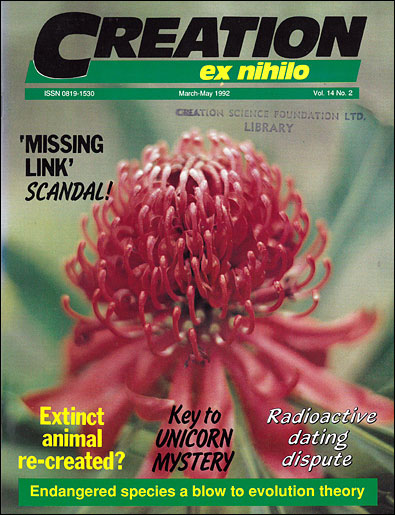Is there any such thing as a ‘higher’ creature?
The so-called ‘simple’ and ‘primitive’ eye of a trilobite is an incredibly complex optical system. One researcher noted:
‘…The trilobites [were] first in developing highly organized visual organs, but some of the recently discovered properties of trilobites’ eye lenses represent an all-time feat of function optimization…Their optical apparatus raises very relevant questions as to why such perfection was needed.’1

Others have added that they believed that:
‘…through natural selection operating on chance variations—trilobites evolved a remarkably sophisticated optical system. For an optical engineer to develop such a system would require considerable knowledge of such things as Fermat’s principle, Abbe’s sine law, Snell’s laws of refraction, the optics of birefringent crystals, and quite a bit of ingenuity.’2
Problem for Darwin
To form these organs, it is postulated that several beneficial mutations occurred together, in unison, to produce a highly complex structure in order to aid the animal in the competition for life. Grasse’ closed his anatomical discussion on the ant (Myrmelion) with these words:
‘Have you ever seen a mutation simultaneously affecting two separate components of the body and producing structures that fit one another precisely? . . . have you ever beheld three, four, or five simultaneous mutations with matching structures producing coordinated effects?…These are vital questions that demand an answer. There is no way of getting round them, or evading the issue. Every biologist who wants to know the truth must answer them, or be considered a sectarian and not a scientist. In science there is no “cause”? to be defended, only truth to be discovered. How many chance occurrences would it take to build this extraordinary creature (Myrmelion formicarius) that braves the burning sands of the Sahara, endures prolonged fasting, economizes water, detects the slightest vibration in the ground, lies in wait for days on end at the bottom of a funnel, or goes forth, freely, to hunt down its prey?’3
Darwin also saw this problem and its seriousness for his theory. In his own words:
‘To suppose that the eye with all its inimitable contrivances for adjusting the focus to different distances, for admitting different amounts of light, and for the correction of spherical and chromatic aberration, could have been formed by natural selection, seems, I freely confess, absurd in the highest degree.’4
This same problem exists for every organ and structure of every animal, although some animals provide better examples than others.
Natural selection defined as the weaker animals’ being less able to survive is a simple fact, but can it account for the development of complex mechanisms?
Natural selection would tend to select for:
- a greater number of offspring
- the length of the fertility period and not the length of the animal’s life.
These factors are the requirements for Darwin’s ‘survival of the fittest’ theory, yet the number of offspring, longevity, and length of the fertility period of most animals have been remarkably stable for the past several hundred years and, according to current evidence, remarkably stable for the past several thousand years!
Nature would not ‘select’ to develop extremely complex mechanisms, such as exist on the bombardier beetle, the firefly, the archerfish, etc., but would be expected to select mechanisms which clearly and directly facilitate what is defined as evolutionary success, that is, the number of offspring that survive to reproduce themselves at any given time. Evolution would not select for complexity, longevity, or even quality of life, but almost exclusively for length and fertility of reproduction periods!
Evolution’s failure

There is actually an inverse relationship between supposed evolutionary development and survival. Animals that are supposedly higher on the evolutionary scale are in general more vulnerable to extinction. This is illustrated by the fact that as of 1991 there were only 21 species of insects on the United States Department of Interior Endangered Species List out of more than one million types identified, but there are 337 species of mammals on the list out of 4,400 identified types! Mammals are thus almost 4,000 times more likely to be threatened with extinction than insects.
Animal types that seem least likely to be bothered by predators, such as birds, have 240 varieties on the list! Although there are 102 types of fish and 107 reptiles, only 19 amphibians, 11 snails, 10 crustaceans and, ironically, 41 clams (mussels) are on the list. Looking at the animals that have already become extinct in recent times, we find most of them are mammals (supposedly the ‘highest’ type of animal) including the Badlands Bighorn (which became extinct in 1910), the sea mink (1890), and the Eastern Elk (1880).
Thus, animals on the ‘higher’ end of the evolutionary scale are actually in far more danger of becoming extinct—and those animals lower on the hypothetical scale are clearly in far less danger. This difference is especially great if the ratio is calculated—out of about a million species of insects, only 21 are in danger of becoming extinct (.002 per cent), though out of almost 4,400 mammals, 337 (7.6 per cent) are in danger—3,800 times more!
On the face of it, this information is the opposite of what the evolutionary model would predict. Survival of the fittest does not propel animals to a ‘higher level’ of permeability against extinction by developing more complex organs. Actually, from such an evolutionary perspective, viruses and bacteria should be the ‘highest’ forms of life on the evolutionary scale!
References
- R. Levi-Setti, Trilobites, University of Chicago. Press, Chicago, 1975. Return to text.
- S. Stanley and D.Raup, Principles of Paleontology, 2nd Edition, 1978, p. 182. Return to text.
- Pierre Grasse, Evolution of Living Organisms. Academic Press New York, 1977, p. 163. Return to text.
- Charles Darwin, The Origin of the Species, London, 1859. sixth edition and various reprints, p. 170. Return to text.


Readers’ comments
Comments are automatically closed 14 days after publication.